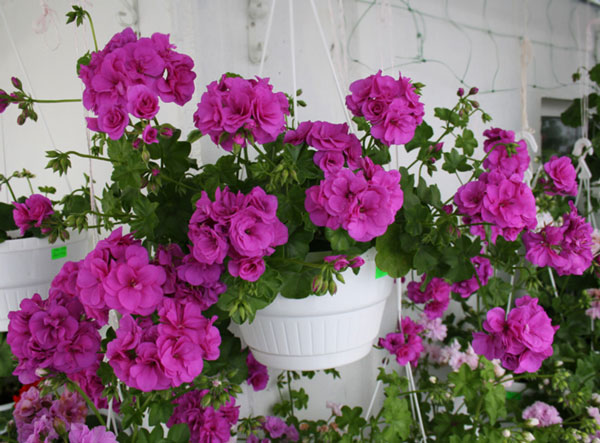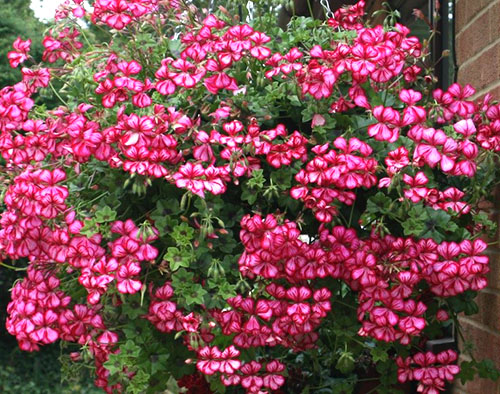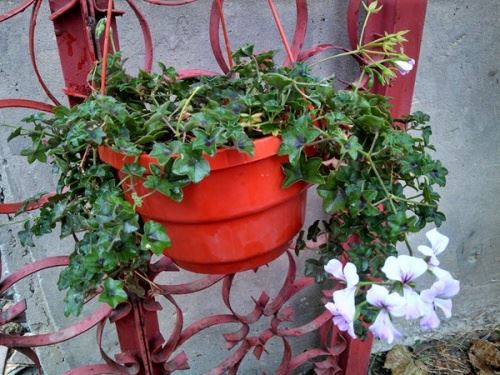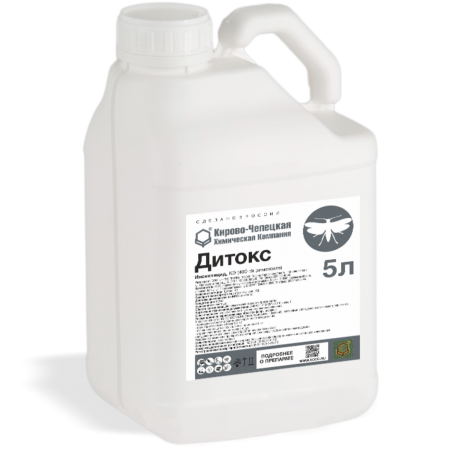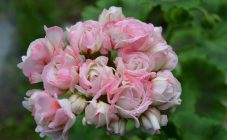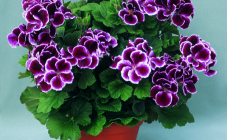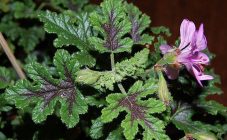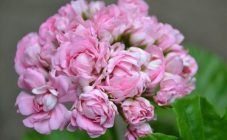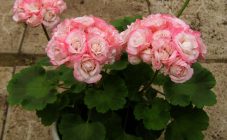Content:
Among garden flowering plants, ampelous flowers are of particular value, from which you can create real hanging multi-colored flower beds with bright cascades of flowering buds and openwork foliage. Pelargonium ivy belongs to the most beloved and popular representatives of ampels and surprises with an abundance of color shades, a variety of inflorescences and the shape of leaves. Baskets with long stems of the plant, richly decorated with flowers, resemble a multi-colored blooming cloud that adorns balconies, terraces and walls of houses in summer.
Description of the plant
Pelargonium ivy was "born" in South Africa, its Latin name - Рelargoniya-plyushchelistnaya, belongs to the Geraniev class. The flower was brought to Europe at the beginning of the 18th century, since then this decorative culture has acquired many new and diverse varieties.
Ivy-leaved pelargonium is a striking representative of ampelous dwarf shrubs, its long and drooping shoots reach lengths from 30 cm to 1 meter. Description of the plant:
- Flowers, similar to asterisks, of a simple or double shape, are located on long pedicels, collected in 5-9 pieces in corymbose inflorescences. Bright and varied colors: from white to maroon shades, arouses genuine admiration for their decorativeness.
- Shoots are straight or slightly curly, when hanging from the pots, they can intertwine with each other. The stems are smooth and firm to the touch. Long shoots can break under the influence of strong winds, so it is undesirable to plant the plant in highly ventilated places.
- The leaves are similar to the climbing ivy plant, it is this similarity that explains the name of the flower "ivy". The leaves are delicate and smooth, with a smooth glossy "leathery" surface, grow up to 5 cm in width.
According to gardeners, pelargonium is considered an unpretentious flower crop, loves well-lit sunny places, requires moderate watering and can easily withstand short-term drought. During flowering, dried flowers fall off on their own, which contributes to the self-cleaning of the bush.
Characteristics of crop varieties
If we consider the flower catalogs of these unusual representatives of the geranium family, it will be difficult to give preference to any one variety - they all amaze with their magnificent color shades, the shape of the inflorescences, the multi-colored color of the leaves. Currently, many beautiful pelargonium varieties have been bred with various botanical characteristics.
Among all the varieties, there are several of the brightest representatives of this beautiful flower culture:
- The ampelous variety seems to be created for a hanging flower club, its long shoots with a mass of bright flowers grow up to one meter in length. The appearance of the inflorescences can be compared with peonies asterisks, the flowering is abundant and long until the first frost. There are specimens with unusual flower inflorescences. Red flowers look especially colorful, which, like bright lights, stand out against the background of a mass of green leaves.
- Terry varieties are distinguished by lush flowers with a wavy edge. In appearance, they resemble garden peonies or terry carnations.The fluffy petals are slightly curved, so tightly gathered in the flower bud that they completely hide the yellow core of the flower.
- Toscana maxima cultivar. Pelargoniums of this large varietal group are decorated with numerous flowers of a red-burgundy shade with small white strokes located throughout the petal. Double semi-double inflorescences consist of wide petals. Ampelous plant, collected in a compact bush. Maxima pelargonium blooms very effectively and resembles huge caps that bloom for a long time and do not fall off for a month.
- Marlen belongs to the Toscana cultivar, blooms with beautiful lilac buds. The plant is very attractive and hardy. Pelargonium Marlene is intended for outdoor cultivation, pleases with its flowering from April to late autumn. For lush flowering, the plant is preferably placed in a sunny place.
- Pelargonium CROCODIL is distinguished by its original leaf color, which resembles a crocodile skin. The decorativeness of this species consists in the presence of bright yellow veins, which stand out in contrast against the green background of the leaves. The plant blooms with bright pink buds, with burgundy patterns at the base of the flower. Pelargonium Crocodile is valued for its unusual appearance, which looks very impressive even without inflorescences.
- Variety Patricia. This hybrid variety is created on the basis of ivy and zonal pelargonium. Large double-shaped flowers are collected in a "rosette" of pearl-pink colors and attached to long peduncles. Beautiful leaves of an emerald hue with a bright zonal ring spot are in perfect harmony with the caramel delicate tones of flowering inflorescences. The bush quickly grows in breadth and fills the entire space of the basket or pots.
The above list of the best varieties of ivy-leaved pelargonium reflects only a small part of the varieties of this beautiful flower. Namely, thanks to the variety of shapes and colors, this plant is gaining more and more popularity.
Features of planting and care
The cultivation of ivy-leaved pelargonium and caring for it at home are not much different from the standard agricultural technology for growing garden flowers. True, there are several important features of planting pelargonium in indoor conditions and in the open field:
- Lighting. Ampel species prefer lighted and sunny places, like to "sunbathe" in direct sunlight. If the plant is intended for planting in open ground, then slightly shaded areas of the garden or summer cottage are more suitable for it.
- The soil. Pelargonium ivy prefers light nutrient substrates with a small addition of clay. The soil mixture is made up of the following components: peat, sand, sod and leafy earth, taken in equal proportions. You can use a commercially available multipurpose earthen mixture or a special one with the inscription on the label "For pelargonium".
- Watering. For lush and long flowering, it is important to provide two-time moderate watering with settled water at room or summer temperature. The plant is very responsive to good moisture, but does not tolerate excess moisture.
- Pruning. To make the pelargonium bush more attractive, many growers periodically prune its green shoots. After this procedure, the flower becomes healthier and continues to bloom profusely. In late autumn, pre-winter pruning of the plant is carried out. By this time, abundant flowering ends, and a period of dormancy begins. By winter, the stems of pelargonium are cut short and only one shoot with 5-7 leaves is left.
Reproduction of culture
Pelargonium ivy is propagated by cuttings or seeds. Experienced growers advise using cuttings of the mother bush for cultivation of a culture, which, after rooting, are able to completely preserve their varietal characteristics. In order to figure out how to root ivy pelargonium, it is recommended that you familiarize yourself with the step-by-step procedure for preparing and planting cuttings:
- From the upper parts of the green shoots, small pieces are cut, from 7 to 12 cm long.
- Sections are processed with activated carbon powder.
- Prepared shoots must be put to dry in a shady, well-ventilated place for 6-12 hours.
- A layer of expanded clay or broken brick is poured onto the bottom of the planting container and filled with a soil mixture.
- Cuttings 3-4 cm deep into the planting soil and watered abundantly.
- Containers with seedlings are placed in a bright and warm room.
- The seedlings will take 10 to 14 days to root.
- After the cuttings have their own root system, they are seated in separate flowerpots or pots.
To prevent the shoots from stretching and forming a compact bush, it is recommended to pinch the seedlings after the appearance of several pairs of leaves.
Seed method
In the event that it is not possible to root the plant with cuttings, you can try to propagate pelargonium by seed. For the successful cultivation of this flower culture with seeds, a florist will need to be patient and familiar with the rules for planting seeds:
- A little sphagnum moss should be added to the soil mixture.
- The seed is placed on a pre-moistened soil at a shallow depth, up to 1 cm.
- The crops are covered with a translucent material and periodically ventilated to prevent condensation from forming.
- Seedling boxes are placed in a warm, well-lit place for germination.
After 10-12 days, the first seedlings of seedlings appear, which must be opened at the age of one month.
How to store ivy pelargonium in winter
Cloak-like pelargonium, as a resident of distant Africa, feels great under the hot sun in summer, and in the winter it has to be sheltered in a place protected from the cold. For this purpose, you can use glazed balconies, loggias, verandas, light attic rooms, summer kitchens. The main condition for successful wintering is the correct temperature regime: from 0 to +10 - +12 degrees. The plant is occasionally watered, trying to prevent the soil from completely drying out. During the winter storage period, it is necessary to take care of the plants: periodically remove yellowed leaves and dried shoots.
In regions with warm winters, it is allowed to preserve pelargonium in places of constant growth. For this, protective shelters are constructed from agrofibre stretched over wire arcs.
Agrotechnics of plant care
Despite its unpretentiousness, the plant is susceptible to a number of diseases. Almost all diseases are caused by improper care and growing conditions. Due to excessive moisture, the flower is affected by fungal diseases, which appear as brown or rusty spots on the leaves. For treatment, fungicide preparations are used, with which it is necessary to periodically spray the entire plant.
In addition to fungal diseases, insect pests such as various mites, aphids and trips pose a great threat. The main reason for their appearance is high temperatures and dry air. There is a small degree of damage, you can get by with a mixture of laundry soap and mineral oil. A higher degree has to be treated with chemicals such as "Ditox", "Iskra" or tobacco dust.
With proper care and compliance with the breeding conditions, Pelargonium ivy will generously thank the grower with a flowering cascade of beautiful flowers.
